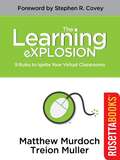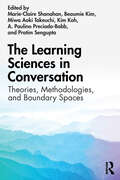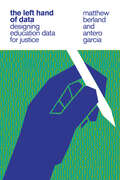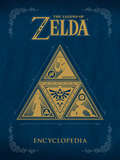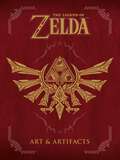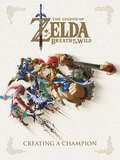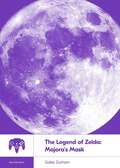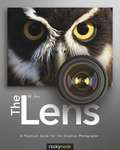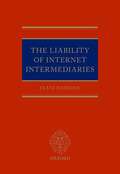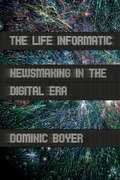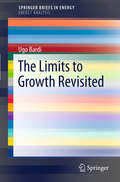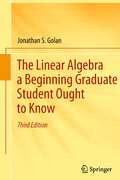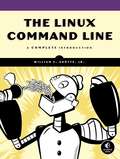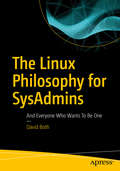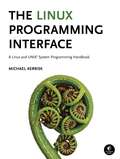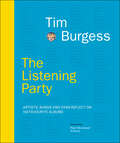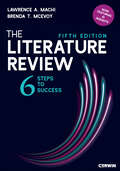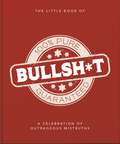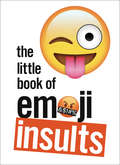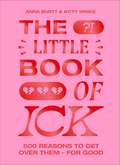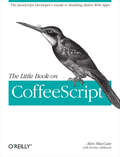- Table View
- List View
The Learning Explosion
by Treion Muller Matthew MurdochMaking the move to online teaching and learning can be challenging, and professionals and laypeople alike want to know the best ways to accomplish the switchover without sacrificing the quality of the material that is being taught. The ultimate challenge is how one transfers the in-person teaching experience and to retain the quality of that experience in the online world in a way that maintains its original integrity. Ultimately what we want is an experience that is challenging and just as engaging as the experience one would get in a live classroom. This book helps readers learn how to transfer their in-person classroom experience and skills to the virtual classroom.
The Learning Sciences in Conversation: Theories, Methodologies, and Boundary Spaces
by Pratim Sengupta Marie-Claire Shanahan Beaumie Kim Miwa Aoki Takeuchi Kim Koh A. Paulino Preciado-BabbThe Learning Sciences in Conversation explores the unique pluralities, complex networks, and distinct approaches of the learning scientists of today. Focused on four key scholarly areas – transdisciplinarity, design, cognition, and technology – this cutting-edge volume draws on empirical and theoretical foundations to illustrate the directions, perspectives, methods, and questions that continue to define this evolving field. Contributions by researchers are put in dialogue with one another, offering an exemplary analysis of a field that synthesizes, in situ, various scholarly traditions and orientations to create a critical and heterogenous understanding of learning.
The Learning Sciences in Conversation: Theories, Methodologies, and Boundary Spaces
by Pratim Sengupta Marie-Claire Shanahan Beaumie Kim Miwa Aoki Takeuchi Kim Koh A. Paulino Preciado-BabbThe Learning Sciences in Conversation explores the unique pluralities, complex networks, and distinct approaches of the learning scientists of today. Focused on four key scholarly areas – transdisciplinarity, design, cognition, and technology – this cutting-edge volume draws on empirical and theoretical foundations to illustrate the directions, perspectives, methods, and questions that continue to define this evolving field. Contributions by researchers are put in dialogue with one another, offering an exemplary analysis of a field that synthesizes, in situ, various scholarly traditions and orientations to create a critical and heterogenous understanding of learning.
The Left Hand of Data: Designing Education Data for Justice
by Antero Garcia Matthew BerlandA speculative framework that imagines how we can use education data to promote play, creativity, and social justice over normativity and conformity.Educational analytics tend toward aggregation, asking what a &“normative&” learner does. In The Left Hand of Data, educational researchers Matthew Berland and Antero Garcia start from a different assumption—that outliers are, and must be treated as, valued individuals. Berland and Garcia argue that the aim of analytics should not be about enforcing and entrenching norms but about using data science to break new ground and enable play and creativity. From this speculative vantage point, they ask how we can go about living alongside data in a better way, in a more just way, while also building on the existing technologies and our knowledge of the present.The Left Hand of Data explores the many ways in which we use data to shape the possible futures of young people—in schools, in informal learning environments, in colleges, in libraries, and with educational games. It considers the processes by which students are sorted, labeled, categorized, and intervened upon using the bevy of data extracted and collected from individuals and groups, anonymously or identifiably. When, how, and with what biases are these data collected and utilized? What decisions must educational researchers make around data in an era of high-stakes assessment, surveillance, and rising inequities tied to race, class, gender, and other intersectional factors? How are these complex considerations around data changing in the rapidly evolving world of machine learning, AI, and emerging fields of educational data science? The surprising answers the authors discover in their research make clear that we do not need to wait for a hazy tomorrow to do better today.
The Legend of Zelda Encyclopedia
by NintendoThis 320-page book is an exhaustive guide to The Legend of Zelda from the original The Legend of Zelda to Twilight Princess HD. Make sure to check out the other installments in this unparalleled collection of historical information on the Legend of Zelda Franchise with the New York Times Best Selling books The Legend of Zelda: Hyrule Historia and The Legend of Zelda: Art & Artifacts!A comprehensive collection of enemies and items, potions to poes, an expansion of the lore touched upon in Hyrule Historia, concept art, screencaps, maps, main characters and how they relate, languages, and much, much more, including an exclusive interview with Series Producer, Eiji Aonuma! This, the last of The Goddess Collection trilogy, which includes Hyrule Historia and Art & Artifacts, is a treasure trove of explanations and information about every aspect of The Legend of Zelda universe!An exhaustive compendium of everything from the first 30 years of The Legend of Zelda.An expansion of information from The Legend of Zelda timeline.Rare development sketches of your favorite characters.An extensive database of items and enemies.
The Legend of Zelda: Art & Artifacts
by NintendoMake sure to check out the other installments in this unparalleled collection of historical information on The Legend of Zelda franchise with the New York Times best selling The Legend of Zelda: Hyrule Historia and The Legend of Zelda: Encyclopedia. Also look for The Legend of Zelda: Breath of the Wild — Creating a Champion for an indepth look at the art, lore, and making of the best selling video game! The Legend of Zelda™: Art and Artifacts contains over four hundred pages of fully realized illustrations from the entire thirty-year history of The Legend of Zelda™ including artwork from the upcoming The Legend of Zelda™: Breath of the Wild! Every masterwork is printed on high-quality paper in an oversized format so you can immerse yourself in the fine details of each piece. This book includes rare promotional pieces, game box art, instruction booklet illustrations, official character illustrations, sprite art, interviews with the artists, and much, much more! The Legend of Zelda™: Art and Artifacts collects many of your favorite masterpieces from the storied franchise, as well as rare and never before seen content, presented in one handsome hardcover.Select artwork from the entirety of the franchise! A nostalgic look at the past! An exciting look at the future! Interviews with some of the artists behind The Legend of Zelda™ series!
The Legend of Zelda: Breath of the Wild--Creating a Champion
by NintendoThis ebook is the ultimate companion to the award-winning video game The Legend of Zelda: Breath of the Wild and includes material from its DLC packs. Witness the making of a champion!This book features: • Nearly 50 pages of sketches and official illustrations from Takumi Wada • 296 Pages of design artwork and commentary about the making of the game from creators • 55 Page historical section that divulges an in-depth history of the Hyrule of Breath of the Wild. • Interviews with key members of the development team including Hidemaro Fujibayashi, Satoru Takizawa, Takumi Wada, and Eiji AonumaMake sure to check out the other installments in this unparalleled collection of historical information on The Legend of Zelda franchise with the New York Times best selling The Legend of Zelda: Hyrule Historia, The Legend of Zelda: Art & Artifacts, and The Legend of Zelda: Encyclopedia which detail the first 30 years of this historic video game franchise!
The Legend of Zelda: Majora's Mask (Boss Fight Books)
by Gabe DurhamYou&’ve met with a terrible fate, haven&’t you? Those grim words hang over the entirety of Majora Mask, the sixth entry in the Legend of Zelda series. In his darkest adventure, Link must relive the same three days over and over again to prevent the moon from colliding into the kingdom of Termina and ending the world. Made with a small team in a single year for the Nintendo 64 from the assets of its predecessor, Majora&’s Mask could have been a shameless cash-in—but instead has gained wide recognition as the most mysterious, mature, and touching game in the series. It&’s also the Zelda game that has inspired more inventive fan theories and bone-chilling internet horror stories than might be expected from a high-fantasy adventure. Through rigorous research and a new in-depth interview with Majora&’s North American localizer, Jason Leung, writer and editor Gabe Durham investigates the relationship between Majora&’s fast-paced, adaptive development and the meaning projected onto its story by players—and shines a light on the strange and tumultuous romance between art and fandom.
The Lens
by Nk GuyWhich lens should I buy for my camera? It's such a simple question, but choosing the right lens or lenses is actually one of the most important photographic decisions you can make. Nothing affects the quality of a photo more than the lens. It's no longer just about the megapixels-it's the glass that makes all the difference! Many first-time buyers of DSLRs don't venture past the basic lens included in the box. While some are reluctant to spend more money, others are confused by all the buzzwords or are overwhelmed by all the choices out there. It's really a shame, because interchangeable lenses give you amazing scope for quality photography. Take in vast sweeping scenes with a wide angle lens. Capture faraway birds with a telephoto lens. Examine the tiniest detail of a flower with a macro lens. Record the perfect portrait with a prime lens. Anything is possible when you choose the right lens for the job! This book isn't a simple catalogue of available lenses. New products are coming out all the time, and comparing specific lenses can be difficult. Instead, author N.K. Guy gives you all the information you need to make smart buying decisions. Optical technology is demystified, arcane terminology is decoded, and practical tips are provided. The Lens will help you build the perfect lens collection to suit your needs-now and in the future.
The Liability of Internet Intermediaries
by Jaani Riordan<P>There is no book dedicated to the doctrines and remedies which regulate the legal liability of internet intermediaries.<P> This is surprising, given that we live in an era in which almost all communications and transactions rely upon services provided or facilitated by such intermediaries.
The Life Informatic
by Dominic BoyerNews journalism is in the midst of radical transformation brought about by the spread of digital information and communication technology and the rise of neoliberalism. What does it look like, however, from the inside of a news organization? In The Life Informatic, Dominic Boyer offers the first anthropological ethnography of contemporary office-based news journalism. The result is a fascinating account of journalists struggling to maintain their expertise and authority, even as they find their principles and skills profoundly challenged by ever more complex and fast-moving streams of information. Boyer conducted his fieldwork inside three news organizations in Germany (a world leader in digital journalism) supplemented by extensive interviews in the United States. His findings challenge popular and scholarly images of journalists as roving truth-seekers, showing instead the extent to which sedentary office-based "screenwork" (such as gathering and processing information online) has come to dominate news journalism. To explain this phenomenon Boyer puts forth the notion of "digital liberalism"-a powerful convergence of technological and ideological forces over the past two decades that has rebalanced electronic mediation from the radial (or broadcast) tendencies of the mid-twentieth century to the lateral (or peer-to-peer) tendencies that dominate in the era of the Internet and social media. Under digital liberalism an entire regime of media, knowledge, and authority has become integrated around liberal principles of individuality and publicity, both unmaking and remaking news institutions of the broadcast era. Finally, Boyer offers some scenarios for how news journalism will develop in the future and discusses how other intellectual professionals, such as ethnographers, have also become more screenworkers than fieldworkers.
The Limits to Growth Revisited
by Ugo Bardi"The Limits to Growth" (Meadows, 1972) generated unprecedented controversy with its predictions of the eventual collapse of the world's economies. First hailed as a great advance in science, "The Limits to Growth" was subsequently rejected and demonized. However, with many national economies now at risk and global peak oil apparently a reality, the methods, scenarios, and predictions of "The Limits to Growth" are in great need of reappraisal. In The Limits to Growth Revisited, Ugo Bardi examines both the science and the polemics surrounding this work, and in particular the reactions of economists that marginalized its methods and conclusions for more than 30 years. "The Limits to Growth" was a milestone in attempts to model the future of our society, and it is vital today for both scientists and policy makers to understand its scientific basis, current relevance, and the social and political mechanisms that led to its rejection. Bardi also addresses the all-important question of whether the methods and approaches of "The Limits to Growth" can contribute to an understanding of what happened to the global economy in the Great Recession and where we are headed from there.
The Linear Algebra a Beginning Graduate Student Ought to Know
by Jonathan S. GolanLinear algebra is a living, active branch of mathematics which is central to almost all other areas of mathematics, both pure and applied, as well as to computer science, to the physical, biological, and social sciences, and to engineering. It encompasses an extensive corpus of theoretical results as well as a large and rapidly-growing body of computational techniques. Unfortunately, in the past decade, the content of linear algebra courses required to complete an undergraduate degree in mathematics has been depleted to the extent that they fail to provide a sufficient theoretical or computational background. Students are not only less able to formulate or even follow mathematical proofs, they are also less able to understand the mathematics of the numerical algorithms they need for applications. Certainly, the material presented in the average undergraduate course is insufficient for graduate study. This book is intended to fill the gap which has developed by providing enough theoretical and computational material to allow the advanced undergraduate or beginning graduate student to overcome this deficiency and be able to work independently or in advanced courses. The book is intended to be used either as a self-study guide, a textbook for a course in advanced linear algebra, or as a reference book. It is also designed to prepare a student for the linear algebra portion of prelim exams or PhD qualifying exams. The volume is self-contained to the extent that it does not assume any previous formal knowledge of linear algebra, though the reader is assumed to have been exposed, at least informally, to some of the basic ideas and techniques, such as manipulation of small matrices and the solution of small systems of linear equations over the real numbers. More importantly, it assumes a seriousness of purpose, considerable motivation, and a modicum of mathematical sophistication on the part of the reader. In the latest edition, new major theorems have been added, as well as many new examples. There are over 130 additional exercises and many of the previous exercises have been revised or rewritten. In addition, a large number of additional biographical notes and thumbnail portraits of mathematicians have been included.
The Linux Command Line: A Complete Introduction
by Jr. William E. ShottsYou've experienced the shiny, point-and-click surface of your Linux computer--now dive below and explore its depths with the power of the command line.The Linux Command Line takes you from your very first terminal keystrokes to writing full programs in Bash, the most popular Linux shell (or command line). Along the way you'll learn the timeless skills handed down by generations of experienced, mouse-shunning gurus: file navigation, environment configuration, command chaining, pattern matching with regular expressions, and more.In addition to that practical knowledge, author William Shotts reveals the philosophy behind these tools and the rich heritage that your desktop Linux machine has inherited from Unix supercomputers of yore.As you make your way through the book's short, easily-digestible chapters, you'll learn how to: * Create and delete files, directories, and symlinks * Administer your system, including networking, package installation, and process management * Use standard input and output, redirection, and pipelines * Edit files with Vi, the world's most popular text editor * Write shell scripts to automate common or boring tasks * Slice and dice text files with cut, paste, grep, patch, and sedOnce you overcome your initial "shell shock," you'll find that the command line is a natural and expressive way to communicate with your computer. Just don't be surprised if your mouse starts to gather dust.
The Linux Command Line: A Complete Introduction
by William E. Shotts<P>You've experienced the shiny, point-and-click surface of your Linux computer—now dive below and explore its depths with the power of the command line. <P>The Linux Command Line takes you from your very first terminal keystrokes to writing full programs in Bash, the most popular Linux shell. Along the way you'll learn the timeless skills handed down by generations of gray-bearded, mouse-shunning gurus: file navigation, environment configuration, command chaining, pattern matching with regular expressions, and more. <P>In addition to that practical knowledge, author William Shotts reveals the philosophy behind these tools and the rich heritage that your desktop Linux machine has inherited from Unix supercomputers of yore. <P>As you make your way through the book's short, easily-digestible chapters, you'll learn how to: <br>–Create and delete files, directories, and symlinks <br>–Administer your system, including networking, package installation, and process management <br>–Use standard input and output, redirection, and pipelines <br>–Edit files with Vi, the world’s most popular text editor–Write shell scripts to automate common or boring tasks–Slice and dice text files with cut, paste, grep, patch, and sed <P>Once you overcome your initial "shell shock," you'll find that the command line is a natural and expressive way to communicate with your computer. Just don't be surprised if your mouse starts to gather dust.
The Linux Philosophy for SysAdmins: And Everyone Who Wants To Be One
by David BothReveals and illustrates the awesome power and flexibility of the command line, and the design and usage philosophies that support those traits. This understanding of how to extract the most from the Linux command line can help you become a better SysAdmin. Understand why many things in the Linux and Unix worlds are done as they are, and how to apply the Linux Philosophy to working as a SysAdmin. The original Unix/Linux Philosophy presented foundational and functional tenets - rules, guidelines, and procedural methods - that worked well. However, it was intended for the developers of those operating systems. Although System Administrators could apply many of the tenets to their daily work, many important tenets were missing. Over the years that David Both has been working with Linux and Unix, he has formulated his own philosophy – one which applies more directly to the everyday life of the System Administrator. This book defines a philosophy, and then illuminates the practical aspects of that philosophy with real-world experiments you can perform. Inspired by David’s real mentors, and dedicated to them, The Linux Philosophy for System Administrators is a mentor to SysAdmins everywhere; remember - "If you fail you learn." What You Will LearnApply the Linux philosophy to working as a SysAdminUnlock the power of the knowledge you already haveFully understand and access the vast power of the command lineReview the power of Linux as a function of the philosophies that built it Who This Book Is For If you want to learn the secrets that make the best Linux SysAdmins powerful far beyond that of mere mortals; if you want to understand the concepts that unlock those secrets; if you want to be the SysAdmin that everyone else turns to when the bytes hit the fan – then this book is for you.
The Linux Programming Interface: A Linux and UNIX System Programming Handbook (No Starch Press Ser.)
by Michael KerriskThe Linux Programming Interface (TLPI) is the definitive guide to the Linux and UNIX programming interface—the interface employed by nearly every application that runs on a Linux or UNIX system.In this authoritative work, Linux programming expert Michael Kerrisk provides detailed descriptions of the system calls and library functions that you need in order to master the craft of system programming, and accompanies his explanations with clear, complete example programs.You'll find descriptions of over 500 system calls and library functions, and more than 200 example programs, 88 tables, and 115 diagrams. You'll learn how to:–Read and write files efficiently–Use signals, clocks, and timers–Create processes and execute programs–Write secure programs–Write multithreaded programs using POSIX threads–Build and use shared libraries–Perform interprocess communication using pipes, message queues, shared memory, and semaphores–Write network applications with the sockets APIWhile The Linux Programming Interface covers a wealth of Linux-specific features, including epoll, inotify, and the /proc file system, its emphasis on UNIX standards (POSIX.1-2001/SUSv3 and POSIX.1-2008/SUSv4) makes it equally valuable to programmers working on other UNIX platforms.The Linux Programming Interface is the most comprehensive single-volume work on the Linux and UNIX programming interface, and a book that's destined to become a new classic.
The Listening Party: Artists, Bands and Fans Reflect on 100 Favorite Albums
by Tim BurgessThe Charlatans&’ Tim Burgess invites you to the greatest listening party of all time. In 2020 when the world was forced to hit pause on live in-person gigs, Tim Burgess found an ingenious way to bring people together by inviting artists and bands, from Paul McCartney and New Order to Michael Kiwanuka and Kylie, to host real-time album playbacks via Twitter. Relive 100 of the most memorable listening parties here with stories from bands and fans, rarely seen backstage images, and unique insider info from those who created these iconic albums. "Hey Twitter, let's all say a big thanks to Tim for these brilliant events this year! We really needed them. So much great music being talked about.'" - Sir Paul McCartney "Twitter being used for something really positive." - Mary Beard
The Literature Review: Six Steps to Success
by Brenda T. McEvoy Lawrence A. MachiExpert guidance and cutting-edge tools for every researcher. Complex, time-consuming, and steeped in methodologies, conducting a literature review can often feel overwhelming. A go-to resource for researchers for nearly 20 years, The Literature Review simplifies the process with a structured six-step model to narrow your research topic, focus your literature search, negotiate the myriad of books, periodicals, and reports about your topic—and, of course, write the review. The fifth edition of this bestselling book includes step-by-step guidance on how to use artificial intelligence ethically and effectively across the six steps of the literature review process. Additional features of this thoroughly updated guide include: Practical checklists, templates, and visuals to support your research at every stage. Reflective exercises, learning tips, and questions to ensure a deeper understanding of each process. Recommendations on transparency and responsibility when utilizing AI in academic research. Whether you’re embarking on your first literature review or refining your skills, this book equips you with the tools needed to tackle every stage of the literature review process with clarity and precision.
The Literature Review: Six Steps to Success
by Brenda T. McEvoy Lawrence A. MachiExpert guidance and cutting-edge tools for every researcher. Complex, time-consuming, and steeped in methodologies, conducting a literature review can often feel overwhelming. A go-to resource for researchers for nearly 20 years, The Literature Review simplifies the process with a structured six-step model to narrow your research topic, focus your literature search, negotiate the myriad of books, periodicals, and reports about your topic—and, of course, write the review. The fifth edition of this bestselling book includes step-by-step guidance on how to use artificial intelligence ethically and effectively across the six steps of the literature review process. Additional features of this thoroughly updated guide include: Practical checklists, templates, and visuals to support your research at every stage. Reflective exercises, learning tips, and questions to ensure a deeper understanding of each process. Recommendations on transparency and responsibility when utilizing AI in academic research. Whether you’re embarking on your first literature review or refining your skills, this book equips you with the tools needed to tackle every stage of the literature review process with clarity and precision.
The Little Book of Bullshit: A Load of Lies too Good to be True (The\little Book Of... Ser.)
by Orange Hippo!The Golden Age of Bullshit.Welcome to the golden age of bullshit, a wiki-wild world knee deep in half-truths and alternative facts, spin and bias, influence and insincerity, little white lies and tall tales, falsehoods and propaganda, and all sorts of other baloney designed to disguise fact from fiction. We live in a post truth, fake news, world where nothing is quite as it seems and everything you read should be seen before believed. But isn't.From Brexit buses to Donald Trump, the University of Google to misleading advertising claims, and everything in-between, the bullshit keeps getting bigger and stronger and the lies are turning truer every day. It's time to call bullshit on bullshit!The Little Book of Bullshit is the ideal antidote everybody needs to fight the influx of excessive lying and cheating and defrauding that has come to define the 21st century, a tiny tome stuffed with delightfully witty snack-sized nuggets of facts and stats and quotes and boasts all related to the ever-expanding world of bullshit."The first rule of bullshit is that it must be believable." Nassim Nicholas Taleb"I'm almost finished..." All of us, at some point in our lives
The Little Book of Emoji Insults
If you can't say something nice... say it in emoji.Shock your friends and family with this brilliantly offensive collection of emoji put-downs and comebacks.With this handy guide, the endless potential for a punishing emoji burn will be opened to you like never before – far beyond just relying on the classic middle finger symbol. From everyday insults to brutal Shakespearean zingers, classic movie put-downs to the best ‘your mum’ jokes, this is your complete phrasebook for the ever more savage world of emoji insults.
The Little Book of Ick: 500 reasons to get over them – for good
by Kitty Winks Anna Burtt· When they mistime a beat drop in the car· When their toenail scrape you in bed· When they sit at a bar stool and their feet hang awkwardly· When they run out of what they want to order in a restaurant and they say, 'I was really looking forward to that' ... You've been dating a guy for a while and you notice something about them that turns your stomach. That's the 'ick' - it might be something weird or unremarkable, it might even be something you do yourself. Whatever it is, once you've got the ick there's no going back from it and, for better or worse, it's onto the next swipe. The Little Book of Ick is a celebration of the dating phenomenon that plagues millions. Split into chapters that chart all the stages of finding love, this book is a collection of 500 hilarious icks: some you'll have already encountered, all ready for you to use when you need to get over someone - qu-ick-ly!Cutting, relatable, witty, sharp - The Book of Ick will reassure you it's fine to be fussy, it might even soothe your future heartbreak ... or just make you laugh on the loo.
The Little Book of Ick: 500 reasons to get over them – for good
by Kitty Winks Anna Burtt· When they mistime a beat drop in the car· When their toenail scrape you in bed· When they sit at a bar stool and their feet hang awkwardly· When they run out of what they want to order in a restaurant and they say, 'I was really looking forward to that' ... You've been dating a guy for a while and you notice something about them that turns your stomach. That's the 'ick' - it might be something weird or unremarkable, it might even be something you do yourself. Whatever it is, once you've got the ick there's no going back from it and, for better or worse, it's onto the next swipe. The Little Book of Ick is a celebration of the dating phenomenon that plagues millions. Split into chapters that chart all the stages of finding love, this book is a collection of 500 hilarious icks: some you'll have already encountered, all ready for you to use when you need to get over someone - qu-ick-ly!Cutting, relatable, witty, sharp - The Book of Ick will reassure you it's fine to be fussy, it might even soothe your future heartbreak ... or just make you laugh on the loo.
The Little Book on CoffeeScript
by Alex Maccaw<p>This little book shows JavaScript developers how to build superb web applications with CoffeeScript, the remarkable little language that’s gaining considerable interest. Through example code, this guide demonstrates how CoffeeScript abstracts JavaScript, providing syntactical sugar and preventing many common errors. You’ll learn CoffeeScript’s syntax and idioms step by step, from basic variables and functions to complex comprehensions and classes.</p>
